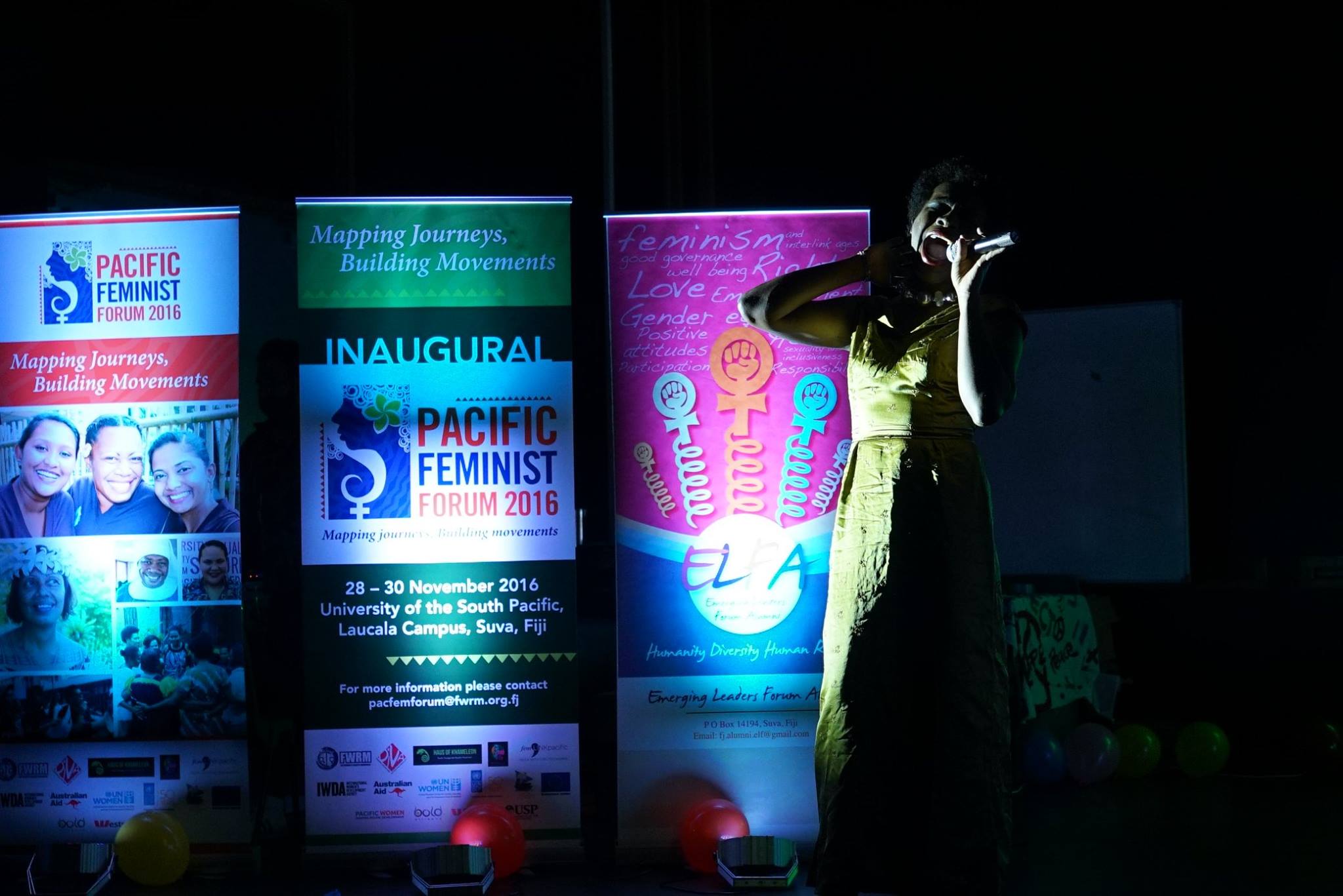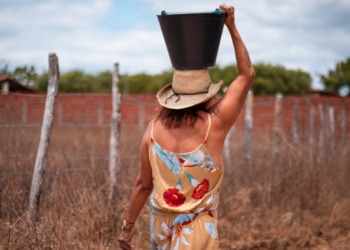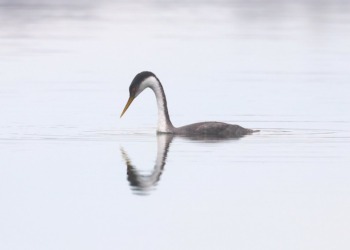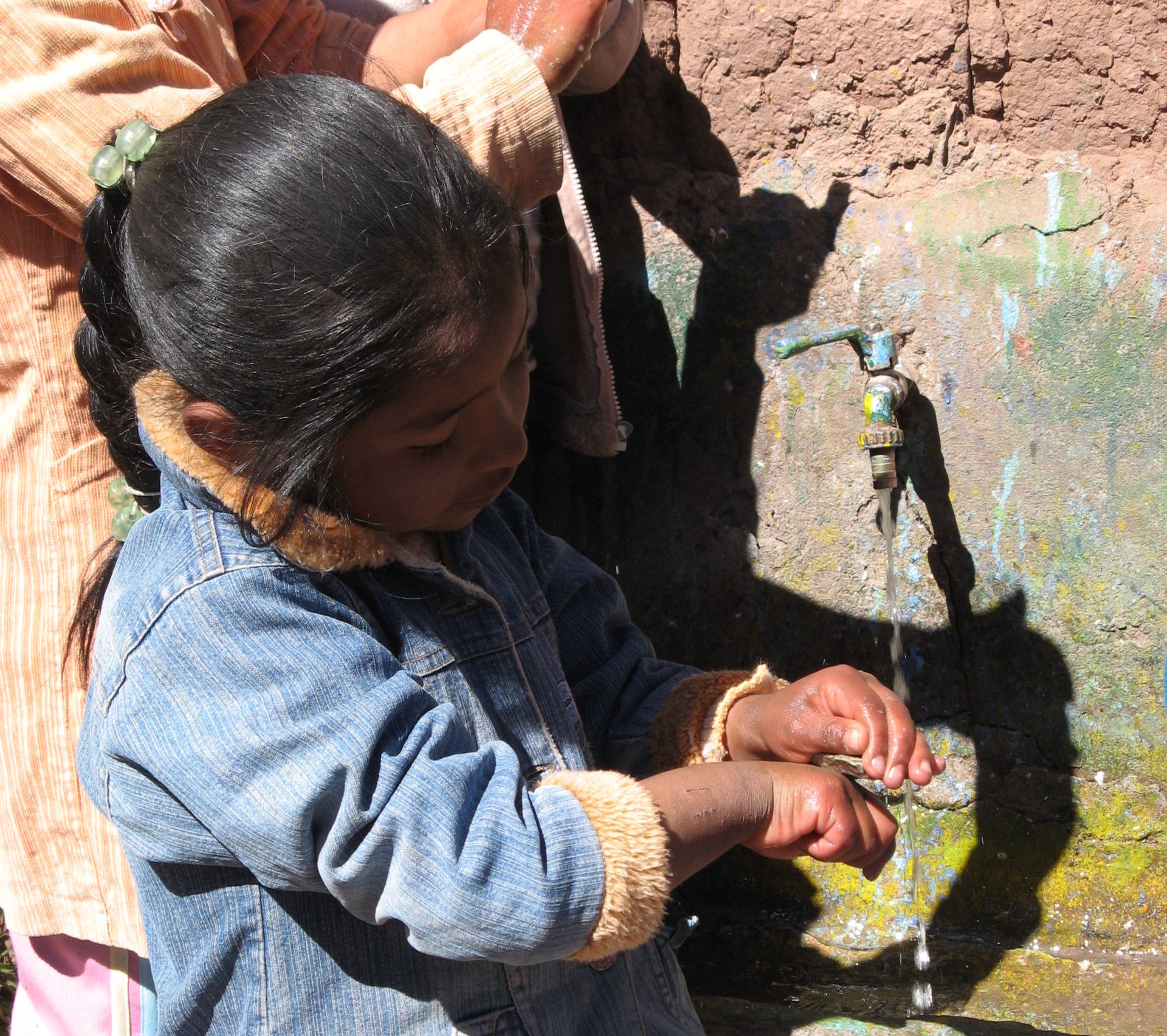What do we read about in the media when it comes to the Sustainable Development Goals (SDGs) and the Pacific? There have been fears expressed lately by the UN that the SDGs are not being met– at all– in the Pacific. Further, there are reports that what is being done in the Pacific is not being measured adequately such as the data gaps. A third concern relates to Goal 5 of the SDGs which elevate gender equality and the empowerment of all women and girls.
A central concern regarding Goal 5 is that women’s leadership in politics is suffering setbacks in the Pacific, with the example of Papua New Guinea. In 2017 not a single woman was elected despite the fact that a record number of women candidates, 167, contested the elections. However, I argue that there is a great strength in the diversity of women and girls’ leadership in grassroots spaces that are worth shining a light on.
Goal 5 of the Sustainable Development Goals is a hard fought for standalone policy on the empowerment of all women. Target 5.5 is to ensure women’s full participation and equal opportunities that lead to leadership at all levels of decision-making in political, economic, and public life. The indicators for this target cover parliamentary representation and management roles.
Women’s representation in political and economic decision making is a crucial part of achieving gender equality. For example, in the Pacific women’s representation in parliament is among the world’s lowest. However, the wording of the target talks of all levels of leadership.
What is striking is that there is nothing in the goal that covers other spheres of leadership. Surely, we are beyond such a limited understanding of what leadership looks like and where leaders are found. My research on Pacific feminist civil society, based on interviews and participant observation, focuses on alternative spheres and ways of leading. It takes us beyond such a limited definition of leadership and demonstrates what the leadership of a diversity of women looks like. Targets, indicators, and goals should also measure these innovations and alternatives.
Related topics: Queer Woman in the Climate and Energy Fields – Is Gender Equality a Numbers Game? –SDG 5: Achieving Gender Equality – Movement to Empower all Women– The Key to Achieving SDG 5
There has also been criticism of the SDGs that it contains no mention of sexual orientation or gender identity (SOGI) or LGBT people. The indicators and targets ensure that governments are held accountable through the measurement of progress or lack thereof.
It is important, therefore, that Goal 5 for women which specifically states ‘all women’ includes women in all their diversities. It is heartening to see that last month, the first high-level event on gender diversity and non-binary identities was held at the UN Headquarters in New York.
Member states, UN entities, and civil society groups came together to discuss the current state of LGBTQI+ rights globally. It gave space to trans and gender non-conforming individuals to speak about their experiences. They made calls for the UN and the global community to take action to protect their human rights.
Participants noted some progress on rights and representation, with the moderator of the event Imara Jones reflecting that “there are trans people and gender-nonconforming people and gay people and lesbian people and bisexual people who have been elected to offices around the world.”’ However, Jones also made note that there has been unprecedented backlash and violence against the LGBTQI+ communities worldwide.
It is also important to note that this SDG event recognizing non-binary identities was held on the sidelines of the United Nations High Level Political Forum on Sustainable Development 2019.
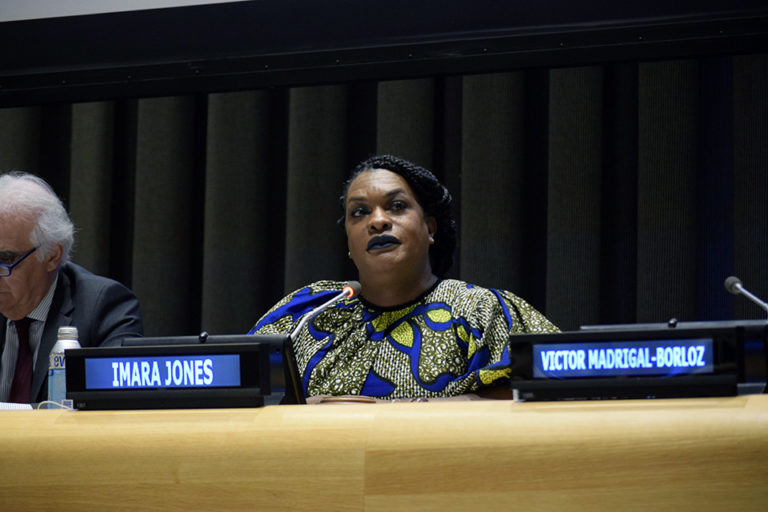
In service to the leave no-one behind agenda of the SDGs, Pacific feminists are leading the building of grassroots alliances in order to amplify the voices of women of diverse sexual orientation and gender identities. They are leading the way regionally and globally, including through their active participation at the abovementioned UN side-event.
In order to demonstrate this diverse and non-binary grassroots leadership, we can examine the Pacific Feminist Forum. In 2016 a 3-day Pacific Feminist Forum (PFF) was held in Suva, Fiji and the author was a participant at that Forum. The women coming together at the PFF came from diverse backgrounds.
Some women present at the PFF have been active in organizations and participate at institutional forums already. For example, some were at the United Nations CSW where queer and trans issues have been traditionally sidelined; there Pacific activists successfully lobbied to have references to ‘lesbian and bisexual women’ and ‘women in all their diversities’ be included in the meeting’s Outcome Statement. This addition was a direct result from the feminist organizing of these disparate individuals and organizations from the PFF.
Aimed at generating strategies, allies, and effective networks, the goals of PFF is gender equality for all Pacific women and girls. It is a strong example of Pacific women creating their own platform if the one there is not available to speak from. This is leadership, yet it is neither in a parliamentary nor an institutional organization. So where is it captured in the SDG measurement? Where will such innovations, like those of the Pacific feminists at these meetings, be represented in the data on women’s leadership?
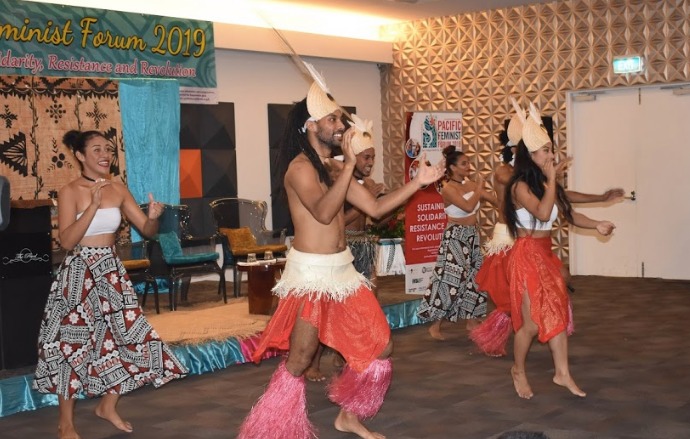
Pacific women the author interviewed spoke of the benefits of global and regional forums to identify and train diverse non-binary women leaders. They saw the face to face meetings as important opportunities to find and teach those who have the potential to become a leader and to expand the notion of who leads.
Interviews further revealed that the Pacific Feminist Forum was perceived as a safe space that facilitated the emergence of a diverse women’s space and network for advocacy. Bottom-up creation of spaces for and by women highlight the inclusive potential of these contexts in contrast to formal spaces and practices that do not hear their voices nor recognize their leadership.
The intention of coming together with a shared vision was described by Pacific feminists as a re-shaping and re-defining of solidarity in a manner that is inclusive yet also acknowledges and respects diversities. The language of the Pacific feminist Charter itself recognizes Pacific feminists as diverse as such differences need to be reflected in the common platform. The charter speaks of:
‘recognition that our strength lies in our diversity, we respect our differences, our journeys as Pacific feminists are diverse, solidarity based on mutual respect and open discussion of differences.’ It aims to ‘have spaces of power shared across diversities, escalate and support innovative feminist social organizing efforts by all Pacific women’.
To further help the Charter’s implementation at the 2nd Pacific Feminist Forum in May 2019 an action plan was drafted to support its use and wider implementation.
The various effects of the Forum have been raised in interviews including information transmission and its importance for building a shared identity of a ‘strategic sisterhood’. This development of these ideas and coalitions aided “collective yet diverse identity formation, intersectional identification, and opened up binaries” explained a young transwoman that was interviewed. Pacific spaces for feminism are also diverse spaces for leadership and action, they are sharing experiences to influence ideas, projects, and programs.
Having experienced exclusion and erasure, Pacific women react positively to the openings of such spaces for diverse women. The PFF was perceived as a valuable new space to ensure a multiplicity of voices were included. One young woman interviewed following her attendance at the PFF saw it as an important space for bringing women in all their diversity from across the region. She felt that “at least they can raise their voice at this forum.”
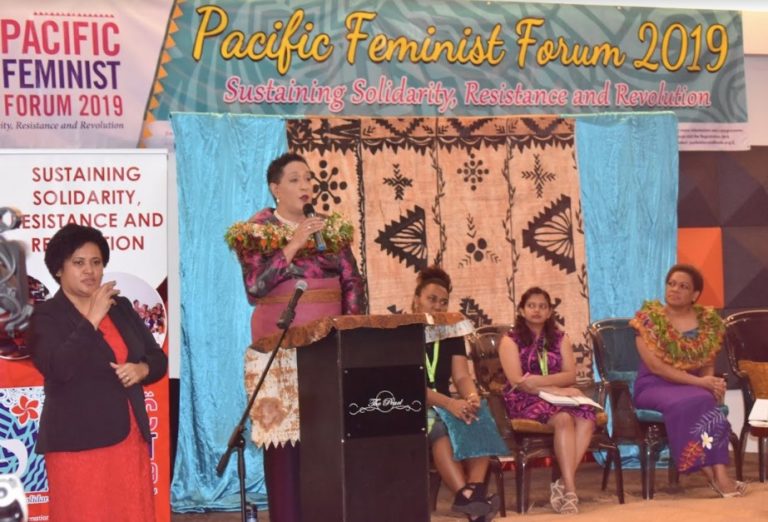
This empirical research is a site for learning and reflection in scholarship on diverse women’s leadership in spaces beyond the parliament and institutional organization. The Forum offered a crucial space for diverse Pacific women to take a more coordinated and structured approach to their collective action at the regional level. The author’s original research insights can be utilized by others wanting to achieve similar outcomes and will be of interest to scholars of social movements and women’s leadership advocates, among a myriad of other diverse women and communities.
Central to sustaining the collective action of the Pacific Feminist Forum is a commitment to self-care which was also raised as a foundational element of Pacific women’s feminism. Lesbian and trans women participants noted the violence and backlash faced by human rights defenders and SOGI activists. Part of this self-care is to bring joy and celebration back into feminist practice. They expressed the importance of providing a safe sanctuary for gender non-conforming Pacific feminists to express themselves and to build supportive alliances and networks who are committed to advocacy on a gender-diverse platform.
The Charter of Feminist Principles for Pacific feminists included a commitment to the advocacy for women in their diversities and a move towards legal recognition of the third gender in the region. Women are leading and participating in meaningful ways in civil society and community-oriented, inclusive spaces.
The PFF demonstrated the value of women’s leadership in grassroots spaces. Why then is this not measured in the SDGs targets and indicators of women’s leadership? The expansion of this intersectional model will be vital to the sustainability of the Pacific women’s movement, especially in light of the gender-based barriers and discrimination women face in the Pacific, as well as the shrinking of civil society spaces.
Interviews and observations confirmed that when Pacific grassroots women use these leadership opportunities, they create spaces for other women to feel included and their voices to be heard. Women of diverse sexual orientation and gender identity expressed that they felt supported by this network. They saw the potential for collective action and to invest their energies to grow a movement that actually backed them.
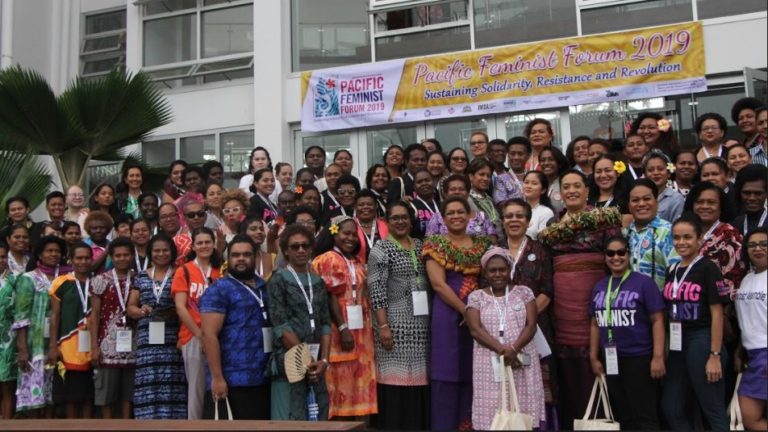
In summary, a spotlight on Pacific feminist civil society can inform the elevation of diversity and non-binary women in leadership roles by highlighting the strength of women’s leadership (active, collaborative, intersectional) in informal spaces.
Rather than wait for spaces to open up or to be (never) ‘invited’ into existing spaces, for instance by government actors at the national level, diverse Pacific women, including non-binary individuals, are creating their own spaces to lead and support others. Grassroots alliances advocating for this recognition have emerged from the bottom up and have been created to achieve greater inclusivity.
For Pacific women’s leadership this latest forum is a mirroring of regional spaces to share stories and journeys and build the feminist movement in the Pacific that is inclusive of diverse women’s leadership. Claiming leadership roles in informal spaces, forming strategic, intersectional alliances, and creating a common platform for change is a leadership model worth tracking and replicating.
Goal 5 of the SDGs indicators talk of women’s leadership at all levels – so let us not forget to look in all the places women lead, and all the ways women exist and express themselves. That progress is what I would like to see measured and targeted.


